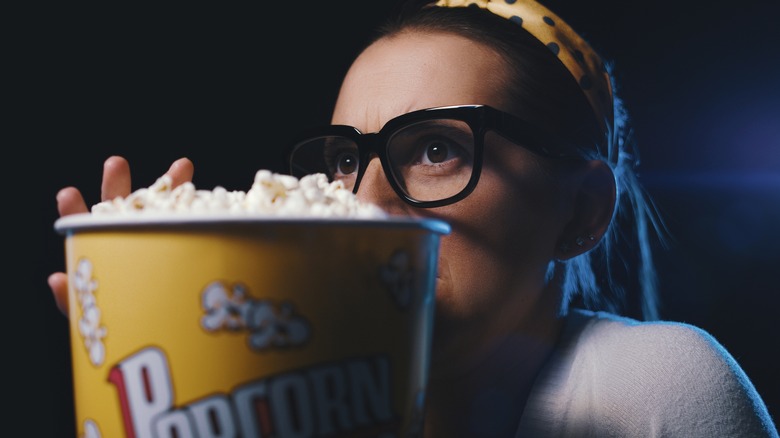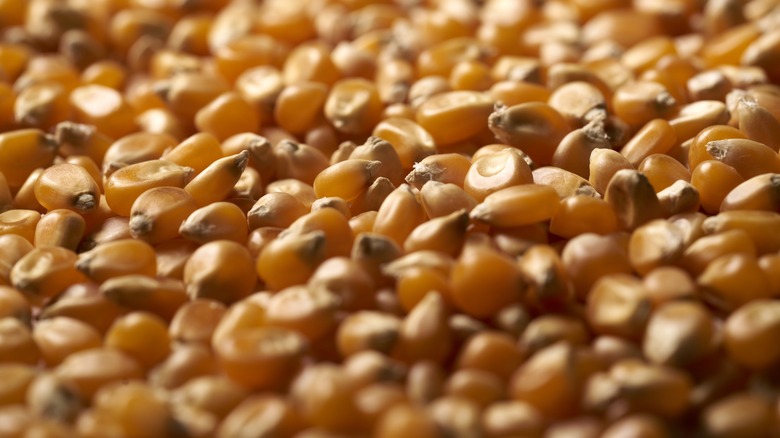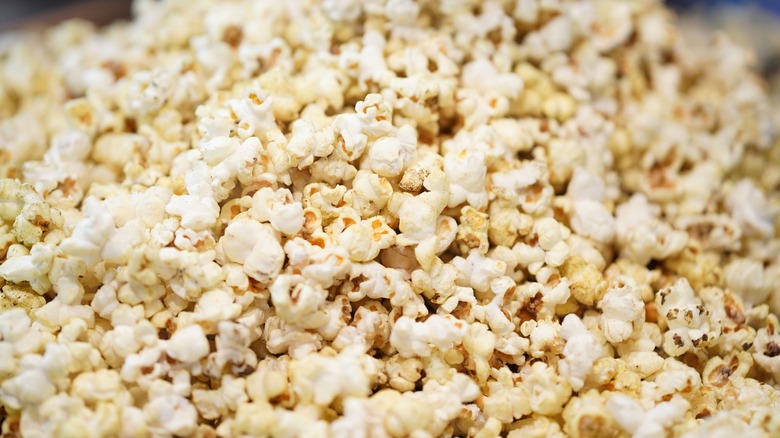How Popcorn Became A Movie Theater Staple
Imagine a movie theater. It could be any theater — one you went to yesterday or one from your childhood that doesn't even exist anymore. It might be a classic old movie palace with ornate carpets, a vaulted ceiling, and a pipe organ to break out on special occasions, or it might be a modern multiplex with stadium seating and an IMAX screen. We can't predict what image your mind will conjure up — but we can assume what it smells like. It smells the same as every other movie theater. It smells like popcorn.
More specifically, it smells like that golden syrup called "butter" that we all know in our hearts is not really butter. Turns out it's a mixture of soybean oil, artificial dye, synthetic preservatives, and an anti-foaming agent called polydimethylsiloxane which happens to be the main component of Silly Putty. Yum!
Now that we've surely spoiled your appetite, let's turn our attention away from the chemicals and talk about why popcorn and movies are so synonymous. Why aren't theaters associated with french fries or ice cream instead? It's not as if popcorn was an innovation of the motion picture era — indigenous Americans were popping maize hundreds of years ago.
The traditional method of toasting the kernels in pottery jars wasn't suited to mass production, but when Chicagoan Charles Cretors invented a popcorn-popping machine in the 1890s, it became a popular sensation. This didn't bring popcorn to the movies though; in fact, it did the opposite.
Popcorn was once banned by movie theaters
The movie theater was a novel institution in the early-1900s, and early proprietors sought to emulate the only theaters that came before them: the Broadway variety. Hence the lavish interiors with oriental rugs and chandeliers that we've come to associate with old movie palaces.
They were built with an affluent clientele in mind because back when movies were silent and reliant on subtitles, only the literate could enjoy them. In keeping with a highbrow image, early theater owners did not want people eating in their establishments. Surely they would make a mess — at least, that was the thinking at the time.
The theater business transformed in late 1927 with the release of The Jazz Singer, which popularized movies with sound. Suddenly, literacy was no longer a barrier to the movies (nor was the patience to read all those subtitles), and theater admissions doubled within just a few years. Still, theater owners clung to the idea that their establishments were highbrow spaces that couldn't risk the blight of carpet kernels and largely refused to sell concessions.
Our urge to snack while we watch movies seems innate, however, and those early days saw many patrons attempting to sneak popcorn into the movies. Street vendors capitalized on the demand, using portable popcorn machines to distribute clandestine snacks outside theaters. They showed that there was a profit to be made off popcorn, and eventually, the theater owners could no longer resist.
The great thing about the Great Depression
There are not a lot of good things to say about the Great Depression: it took lives and tore families apart. However, if it weren't for the Depression, we might not be eating popcorn at the movies today. The economic crisis of the 1930s took a few years to catch up to Hollywood, and in its early years, people flocked to theaters in droves for inexpensive entertainment.
Popcorn was also cheap at the time. Vendors would sell it by the bag for a nickel or dime. With money more precious than ever, movie theater owners could no longer resist the draw of concessions — they were going to sell some popcorn. Initially, theaters would lease lobby space to popcorn vendors, but eventually they installed their own popcorn machines to take control of the profits.
Why popcorn rather than another snack? Thank the Depression again. While popcorn remained cheap throughout the Great Depression and WWII, other concessions did not. Sugary treats like candy and soda became exorbitantly expensive as international sugar imports were cut off and rations were enforced. Popcorn could also be mass-produced with a portable machine, rather than requiring a full kitchen, which couldn't be said for other snacks like potato chips.


